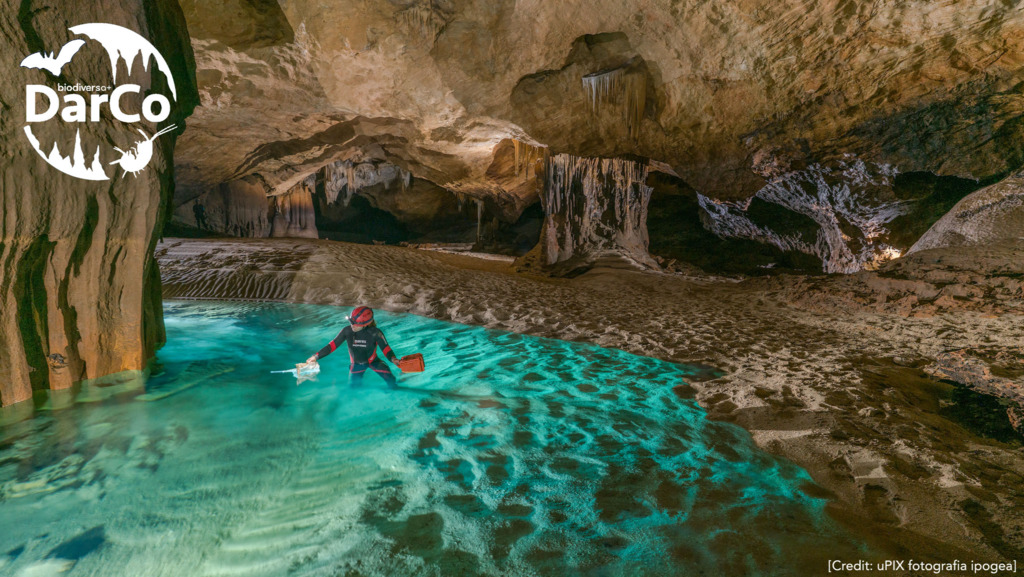NOW WELCOME: European subterranean biodiversity studies invited to a new topical collection

The consortium behind the recently started Biodiversa+ project DarCo encourages participating researchers, as well as any scientist working on the European subterranean fauna and/or its protection and conservation eager to contribute new data and ideas to the project, to submit their papers to a newly launched topical collection in the Subterranean Biology journal.
By collating openly accessible, data-driven scientific evidence, the collection and everyone involved is to prompt the inclusion of subterranean systems in European conservation plans and biodiversity goals (e.g. Habitats Directive, Water Framework Directive, Groundwater Daughter Directive, EU Biodiversity Strategy for 2030).
The collection is curated by leading experts in the field Dr Stefano Mammola (National Research Council of Italy, CNR, and Project Coordinator at DarCo) and Dr Fabio Stoch (Université Libre de Bruxelles, Belgium, and Editor-in-Chief of Subterranean Biology since 2022).
In their endeavour, they are joined by guest editors Prof Ana Sofia P. S. Reboleira (Centre for Ecology, Evolution and Environmental Changes and Universidade de Lisboa, Portugal), Dr Melissa Meierhofer (Finnish Museum of Natural History, University of Helsinki, Finland) and Dr Tiziana Di Lorenzo (National Research Council-Research Institute on Terrestrial Ecosystems, Italy).
As part of a topical collection rather than a Special Issue, once accepted, each paper will be proceeding straight to publication, thereby featuring in the current Subterranean Biology journal volume. Simultaneously, it will also show up in the collection titled “DarCo: Filling knowledge gaps for European subterranean biodiversity towards its effective conservation”, thereby benefiting from increased visibility, outreach, readership and citability, alongside contextually linked research. Up to now, no deadline is fixed for manuscript submission.
“On behalf of the editorial team, I wish to invite researchers studying the hidden wonders of Europe’s underground world to consider Subterranean Biology and our DarCo-inspired collection for their manuscripts. We are looking forward to working with all of you on shedding much needed light on this spectacular, yet overlooked realm,” says Stoch.
To have their manuscripts sent to the collection’s editors and considered for the collection, authors will need to select the option during the manuscript submission process. You can find more information on the collection’s webpage.
Stay updated on the latest news and content from Subterranean Biology on Twitter and Facebook.
***
What does DarCo stand for?
Short for "The vertical dimension of conservation: a cost-effective plan to incorporate subterranean ecosystems in post-2020 biodiversity and climate change agendas”, the DarCo project brings together a multidisciplinary team of leading scientists from 13 research institutes and 11 European countries. They represent curators of main databases on subterranean species distributions and traits, as well as researchers with expertise in taxonomy, ecological modelling, phylogenetic methods, functional diversity, and spatial prioritisation.
In order to map subterranean biodiversity patterns across Europe and develop an explicit plan to incorporate subterranean ecosystems in the European Union (EU) Biodiversity Strategy for 2030, the consortium will first compile existing databases and leverage a network of international collaborators to gather distribution data, traits, and phylogenies for all major subterranean animal groups, including crustaceans, mollusks, insects, and vertebrates.
Then, using those data, the team will model species responses to human threats using different techniques. By intersecting maps of diversity patterns, human threats, and protected areas, the scientists will design a plan to protect subterranean biodiversity complementing the current European Union’s network of protected areas.
Finally, the team will also turn to targeted dissemination and engagement activities, in order to raise societal awareness about subterranean ecosystems and invite stakeholders to incorporate subterranean biodiversity in multilateral agreements.
The major outputs of DarCo will also include the Subterranean Biodiversity Platform, which will serve as a central tool to establish a data-driven dialogue with key stakeholders involved in the study and protection of the subterranean natural heritage.
In line with open science practices and Plan S, the DarCo team will make all data available, so that future generations will be able to build upon the knowledge they will have accumulated by the end of the project, scheduled for early 2026.
***
Don’t forget to also follow DarCo on Twitter (@biodiv_DarCo).